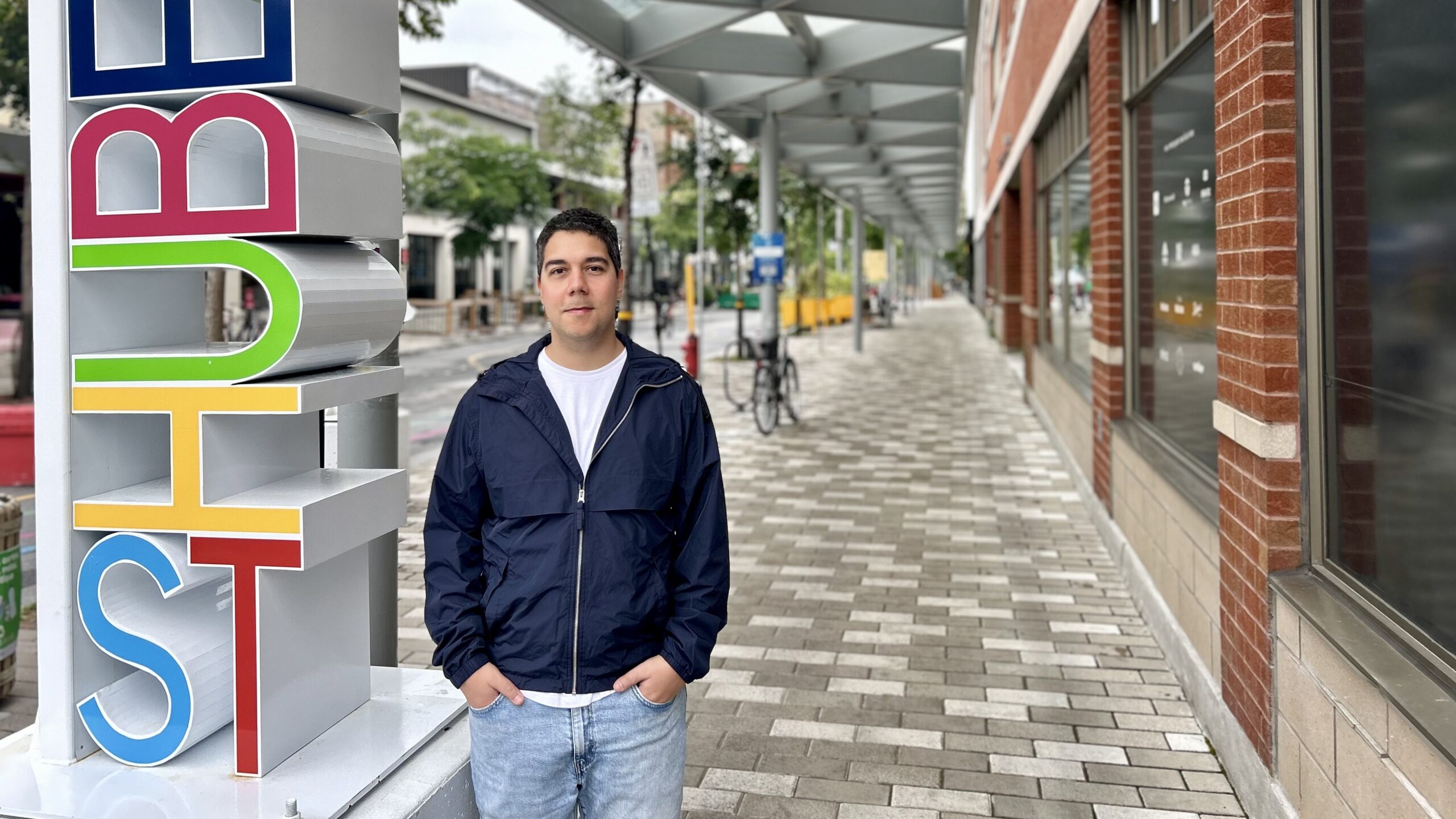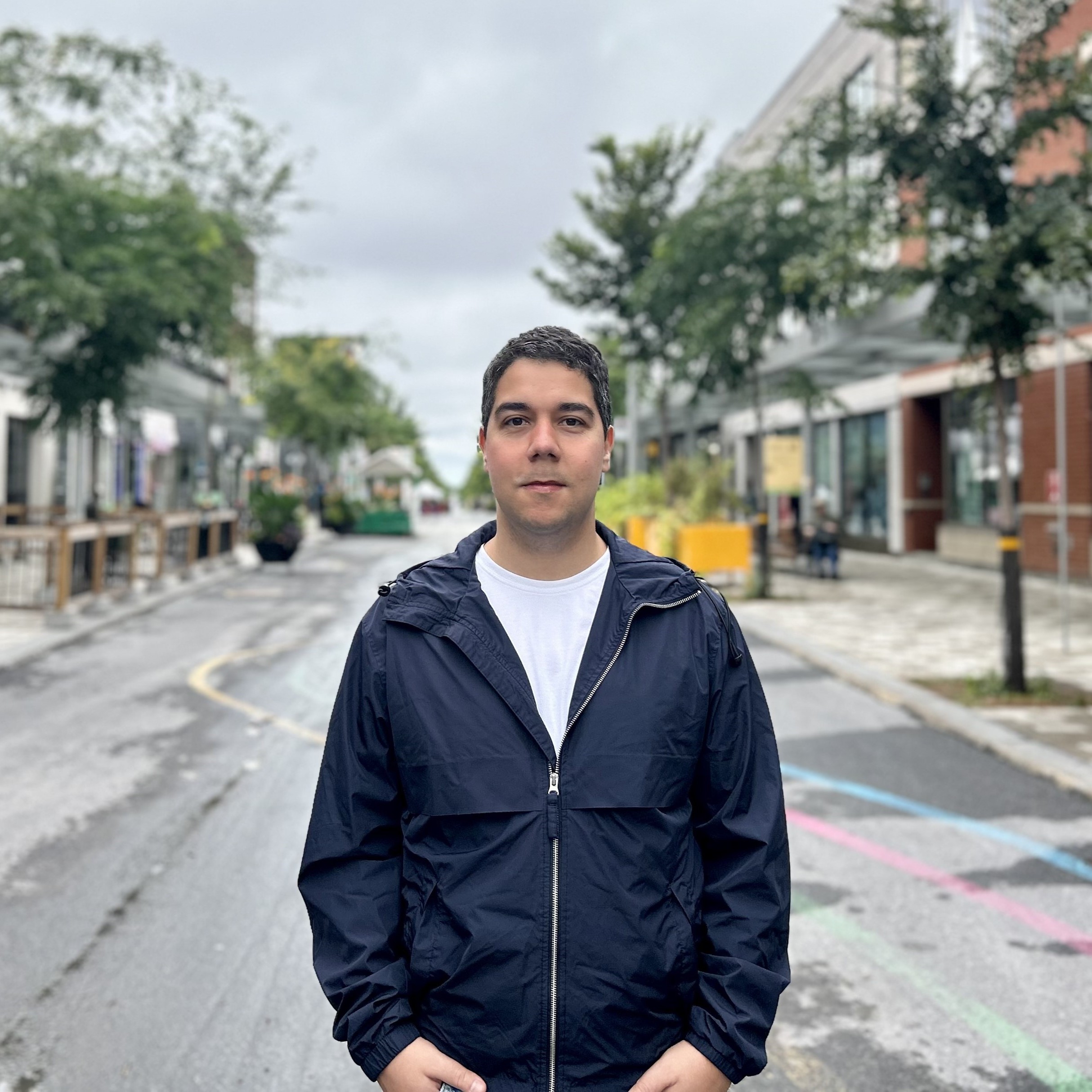- Unlikely Perspectives
The “Unlikely Perspectives” series shines a spotlight on unusual, thought-provoking research topics.

INRS PhD student Bernardo Emmanuel at the entrance to Montreal’s Plaza St-Hubert.
Both immutable in their layout and ephemeral in their dynamics, streets shape cities and the habits of their residents. Although they may remain the same on a map, streets can undergo major demographic, commercial, and urban shifts as public policies, seasons, and eras change.
It is this ephemeral nature of public spaces and their identity that interests Bernardo Emmanuel, who is pursuing a Ph.D. in urban studies at the Institut national de la recherche scientifique (INRS) and the Université du Québec à Montréal (UQAM).
“During my research, I wondered why terms like ‘revitalization’ or ‘renewal’ were used when major works were planned for a street, as if we wanted to breathe new life into a space that was already occupied. It’s as if the existing social life—or the presence of poor or itinerant people—has to be erased to make way for ‘real life’. As if a space is dead when it isn’t part of a capitalist logic,” explains the young researcher.
With this in mind, Bernardo recently co-authored the article “Rue Wellington, Plaza Saint-Hubert… Qu’en est-il vraiment de la « coolitude » des rues défrayant les palmarès ?” (Rue Wellington, Plaza Saint-Hubert… What’s really happening to the ‘coolness’ of the streets that make the headlines?) in The Conversation with professor Anne-Marie Broudehoux, a specialist in environmental design at UQAM. The student and the professor discuss the consequences of certain magazines and tourist organizations such as Time Out ranking the world’s trendiest places.
The “coolness” of streets, or the creation of an identity
Rankings deem a street “cool” based on its art, dining options, cafés, boutiques, nightlife, and, above all, its authenticity in the eyes of the locals.

“Authenticity is a highly complex issue in urban studies. These branding processes, which make certain streets “cooler” and “more authentic” than others, paradoxically do so at the expense of the already established local community… and therefore authenticity.”
Bernardo Emmanuel, P.h.D student inurban studies at INRS and UQAM
The new-found celebrity of these streets undermines their ecosystem, which was based on the socio-cultural makeup of urban spaces, a principle that describes how communities shape their shared spaces according to their cultures, values, and lifestyles. The early signs of gentrification can be seen in rising rents, the arrival of large chains, the influx of tourists, and the relocation of residents.
“As part of the capitalist system, cities want to sell themselves to attract tourism and investment, but do they have to sell everything? How far can this fetishization of space go? Where is the balance between fostering cultural and commercial appeal and respecting the community and its culture, retailers, as well as historically marginalized and forgotten populations?” asks Bernardo.
Concept: The fetishization of space
“Fetishizing” public space means creating an aura around a place to attract consumers and visitors. “Cool streets” are the result of such fetishization, which in this case aims to attract tourists or influencers. The magic of such a public space, which promotes a certain lifestyle and certain habits, is then thought to reflect on the people who frequent it.
Fetishization can have several consequences, such as gentrification or influencers who wish to immortalize their presence in these fetishized places, and thus draw their own followers into this logic of consumption of space.
About the student
Bernardo Emmanuel’s research interests led him to public spaces in Toulouse, France; Brazilian favelas; and the underbelly of viaducts in Rio, before settling in Montreal. Today, he focuses on the way public spaces contribute to the construction of the popular perception of cities and their identity portrayed in films. His thesis, titled “L’espace public imaginaire: l’évolution des représentations filmiques des rues, places et parcs montréalais” (Public space in the collective consciousness: The evolution of film representations of Montreal streets, squares, and parks), is supervised by Christian Poirier, a professor at INRS’s Urbanisation Culture Société Research Centre, who has himself worked on Quebec identity in local cinema.
Bernardo Emmanuel is a young researcher attached to the Fernand-Dumont Chair on Culture at INRS. He has also worked as a lecturer at UQAM.
In 2024, he received two awards for best research on public spaces at the international conference “Past, Present and Future of Public Space”organized by City Space Architecture in Bologna.
As a student committed to his community, Bernardo is also a mentor to graduate students at INRS and a volunteer with GRIS-Montréal (Groupe de recherche et d’intervention sociale), an organization that uses testimonials to demystify LGBTQ+ realities in schools in order to break down prejudice against this community.
